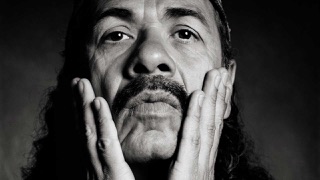

These Spanish interjections ay denoting surprise and caramba a minced oath for carajo is an exclamation used to denote surprise.
Santana formed in 1966, and by the time the band recorded its 1969 self-titled debut, the group’s classic lineup featured guitarist Carlos Santana, singer/keyboardist Gregg Rolie, drummer Michael Shrieve, bassist David Brown, and percussionists Michael Carabello and José “Chepito” Areas.
Neal Schon joined the band as a second guitarist in 1971, and Brown left the group that same year. In 1972, Schon and Rolie exited Santana, and the two went on to co-found Journey the following year.
By 1974, Carlos Santana was the only original member left in the band. Over the years, more than 60 musicians have played in Santana, with Carlos remaining the only constant presence. The current Santana lineup also features bassist Benny Rietveld (first joined in 1990), percussionist Karl Perazzo (joined in 1991), singer/percussionist Andy Vargas (joined in 2000), rhythm guitarist Tommy Anthony (joined in 2005), keyboardist David K. Matthews (joined in 2011), percussionist Paoli Mejías (joined in 2013), drummer Cindy Blackman Santana, Carlos’ wife (joined in 2015), and singer/percussionist Ray Greene (joined in 2016).
¡AY CARAMBA! may have been his response when Carlos Santana was asked to record rock classics that others had previously released successfully. https://www.youtube.com/watch?v=L-5M1_DKvb0
This is because in the 1944 Disney movie The Three Caballeros, Panchito Pistolas screams "Ay, Caramba" and José Carioca asks what it means, but Panchito does not know. https://www.youtube.com/watch?v=PeM164rUJNo
Santaana withstood and embraced a bevy of stylistic shifts, from the psych rock and Latin rock they famously displayed to the half-million patrons at Woodstock, to jazz rock and jazz fusion in a different phase, straight-up AOR in another and an unlikely move to radio pop on their biggest-selling record, released three decades after their debut. It's been quite a career, and it continues. 'Guitar Heaven: The Greatest Guitar Classics of All Time' (2010)
Making Carlos Santana, one of the great guitarists of this or any other age, the central focus of what amounts to a classic rock karaoke record, was a bad idea – one that could have been redeemed by filling the album with some tremendous vocal performances and some left-of-center song choices. Guitar Heaven has a few of these – Chris Cornell was born to sing "Whole Lotta Love" as Santana wore out the hinge on his wah-wah pedal; R&B singer India. Arie gives "While My Guitar Gently Weeps" a slippery, soulful performance; and Chris Daughtry helps Santana crush Def Leppard's "Photograph." Most of the album, though, lacks the kind of inspiring performances found in those three tracks. For example, ever want to hear Train's Pat Monahan sing Van Halen's "Dance the Night Away"? No? Or Creed's Scott Stapp snarling through Creedence's "Fortunate Son"? https://www.youtube.com/watch?v=dF_Te3rcB4g&list=PLKjjIa7cwTkIwKK8pkJwz…
Four decades earlier Carlos outdid himself with Abraxas' (1970) https://www.youtube.com/watch?v=9m9wwP4LNOQ One of the greatest Latin music records ever made (and arguably the greatest Latin rock record ever put to tape), Abraxas fulfills the promise Santana displayed on their self-titled debut by deepening their sound and embracing the abstractions of the psychedelic rock and blues which they excelled. The blues influence is felt on the medley of Fleetwood Mac's "Black Magic Woman" and Hungarian guitarist Gabor Szabo's instrumental "Gypsy Queen," as well as on "Mother's Daughter" and in the guitar refrain of "Incident at Neshabur." The latter track enables the band to show off their ease with different time signatures and the underpinnings of jazz phrasing and comping – things they would more formally experiment with in future, jazz-heavy records. Things get less restrained on "Se a Cabo" and "Hope You're Feeling Better," but for different reasons. The former is a percussion workout like few others, practically demanding the listener get up and move; the latter is a bruising, bluesy hard rock that might draw blood if you get too close to the speakers when it's playing. On Abraxas, Santana shows different paths of getting to the same destination – total immersion in the music of a great young band, with so much more to accomplish.